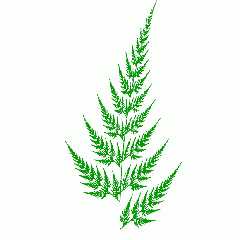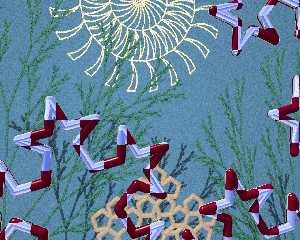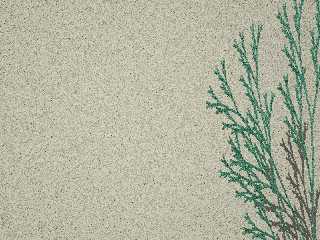 |
 |
|
 |
|
 |
|  |
|  |
|
 |
|
 |
|  |
|  |
|
 |
On 12/8/2010 9:48 AM, Dave Blandston wrote:
> Wonderful! That really is exciting! I'm constantly amazed at the things I see on
> this forum. Thanks for sharing!
I think it reflects well on this particular piece of freeware; you can
do practically anything with it. Mathematical concepts, photorealistic
rendering... logo creation... It's a good time to be a Povver :)
Post a reply to this message
|
 |
|  |
|  |
|
 |
|
 |
|  |
|  |
|
 |
>stbenge on date 08/12/2010 07:13 wrote:
> Greetings!
>
> Last May, "knighty" of fractalforums.com amazed fractal fans worldwide
> when he presented a new class of escape time fractals he calls
> "Kaleidoscopic IFS." Forum members quickly grasped the concept and
> proceeded to create many interesting variants, many of which you can see
> in this seminal thread:
>
http://www.fractalforums.com/3d-fractal-generation/kaleidoscopic-%28escape-time-ifs%29/?PHPSESSID=8fddfae07b02d36cd3c05e028fd6a7d9
>
>
> Jos Leys then went on to describe these fractals in more detail:
> http://images.math.cnrs.fr/Un-ballon-de-foot-fractal.html I highly
> recommend checking out the rest of his site if you haven't done so
> already; he's done some very cool things.
>
> The theory behind these objects is that all polyhedra have a set of
> symmetry planes about which geometry may be reflected. If an iterated
> function is reflected, scaled off-center and tested against a sphere,
> there will be an emergence of new, often unexpected shapes.
>
> I have managed to make a full implementation of the five Platonic
> solids, along with an ad-hoc cavity shader. You can find the scene file
> here:
>
http://news.povray.org/povray.text.scene-files/thread/%3C4cff1d96%40news.povray.org%3E/
>
>
> Perhaps you'll find these fractals as captivating as I do :)
>
> Happy Raytracing!
>
> -Sam
Thank you for the interesting images, Sam, I've always been fascinated
by IFS: they are simple to write and may conduce to unexpected shapes
(the good of iterative algorithms - years ago I made a little 2D IFS
parser in POV-Ray).
;-)
Paolo
Post a reply to this message
|
 |
|  |
|  |
|
 |
|
 |
|  |
|  |
|
 |
On 12/9/2010 1:08 AM, Paolo Gibellini wrote:
> Thank you for the interesting images, Sam, I've always been fascinated
> by IFS: they are simple to write and may conduce to unexpected shapes
> (the good of iterative algorithms - years ago I made a little 2D IFS
> parser in POV-Ray).
> ;-)
> Paolo
Hi Paolo, I wrote an IFS parser too, hoping to figure out how K-IFS
fractals work. It didn't really help, but it was a fun diversion <g>
It's intolerably slow and not very efficient... The attached image took
31 seconds to parse, and has 193317 objects from 28 iterations. The
reference I modeled it from used fewer samples, yet possessed higher detail.
Kaleidoscopic iterated function systems, when computed with an escape
time algorithm, are much more efficient. They take less than a second to
parse and have a minimal memory footprint... and the result is just one
object :)
Now if I could just get the Menger Sponge working... I'm about to
concede defeat :(
Post a reply to this message
Attachments:
Download 'ifsa0_35.png' (18 KB)
Preview of image 'ifsa0_35.png'

|
 |
|  |
|  |
|
 |
|
 |
|  |
|  |
|
 |
On 8/12/2010 5:31 PM, stbenge wrote:
> This was an early failed attempt. It's an example of how the
> "plug-and-chug" method of not doing your homework can go terribly wrong.
> It inspired me to find my own symmetry planes. It's actually not that
> bad, might even make a nice alien space station :)
exactly! not everything HAS to be symmetrical! i like it...
zutroi
Post a reply to this message
|
 |
|  |
|  |
|
 |
|
 |
|  |
|  |
|
 |
>stbenge on date 09/12/2010 19:07 wrote:
> On 12/9/2010 1:08 AM, Paolo Gibellini wrote:
>> Thank you for the interesting images, Sam, I've always been fascinated
>> by IFS: they are simple to write and may conduce to unexpected shapes
>> (the good of iterative algorithms - years ago I made a little 2D IFS
>> parser in POV-Ray).
>> ;-)
>> Paolo
>
> Hi Paolo, I wrote an IFS parser too, hoping to figure out how K-IFS
> fractals work. It didn't really help, but it was a fun diversion <g>
> It's intolerably slow and not very efficient... The attached image took
> 31 seconds to parse, and has 193317 objects from 28 iterations. The
> reference I modeled it from used fewer samples, yet possessed higher
> detail.
>
> Kaleidoscopic iterated function systems, when computed with an escape
> time algorithm, are much more efficient. They take less than a second to
> parse and have a minimal memory footprint... and the result is just one
> object :)
>
> Now if I could just get the Menger Sponge working... I'm about to
> concede defeat :(
Your argumentation are as always convincing ;-), sorry I've no time now
to experiment Kaleidoscopic IFS now.
Paolo
Post a reply to this message
Attachments:
Download 'es_lsystems_20_1280_aa.jpg' (596 KB)
Download 'es_lsystems_08_800_no_aa.jpg' (246 KB)
Preview of image 'es_lsystems_20_1280_aa.jpg'

Preview of image 'es_lsystems_08_800_no_aa.jpg'

|
 |
|  |
|  |
|
 |
|
 |
|  |
|  |
|
 |
Paolo Gibellini <p.g### [at] gmail com> wrote:
> Your argumentation are as always convincing ;-), sorry I've no time now
> to experiment Kaleidoscopic IFS now.
I like the second image. It reminds me of the dendrites (iron? manganese?) one
can sometimes find in rhyolite or sandstone. com> wrote:
> Your argumentation are as always convincing ;-), sorry I've no time now
> to experiment Kaleidoscopic IFS now.
I like the second image. It reminds me of the dendrites (iron? manganese?) one
can sometimes find in rhyolite or sandstone.
Post a reply to this message
|
 |
|  |
|  |
|
 |
|
 |
|  |
|  |
|
 |
>Samuel Benge on date 11/12/2010 20:48 wrote:
> Paolo Gibellini<p.g### [at] gmail com> wrote:
>> Your argumentation are as always convincing ;-), sorry I've no time now
>> to experiment Kaleidoscopic IFS now.
>
> I like the second image. It reminds me of the dendrites (iron? manganese?) one
> can sometimes find in rhyolite or sandstone.
>
Thank you ;-)
The background is a plane with an a agate-based texture, and turning
antialiasing off there is this this granulated effect.
Paolo com> wrote:
>> Your argumentation are as always convincing ;-), sorry I've no time now
>> to experiment Kaleidoscopic IFS now.
>
> I like the second image. It reminds me of the dendrites (iron? manganese?) one
> can sometimes find in rhyolite or sandstone.
>
Thank you ;-)
The background is a plane with an a agate-based texture, and turning
antialiasing off there is this this granulated effect.
Paolo
Post a reply to this message
|
 |
|  |
|  |
|
 |
|
 |
|  |




![]()